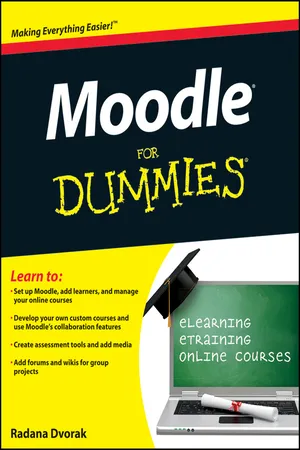Part I
Getting Started with Moodle
In this part . . .
This part hopefully inspires and excites you so much that you won’t be able to contain yourself and will want to digest the whole book and start creating Moodle courses immediately. The part begins with an overview of Moodle and briefly explains its conventions, terminology, and tools. After that, I discuss methods of online learning, how to develop great Moodle courses, and how to use Moodle to support your teaching goals. The last two chapters of this part contain nuts and bolts information that gets you started building your course front page and creating your first Moodle course.
Chapter 1
Discovering Moodle and What You Can Do
In This Chapter
Finding your way around the Moodle course front page Checking out Moodle basic structure and organization Understanding resources, activities, and blocks Mastering Moodle terms and conventions Using new software applications isn’t always easy and can even be overwhelming if you focus on the ever-changing Internet and all the new software and gadgets that keep appearing. When you want to use a new software, you must think about the time (and possibly money) you need to invest initially to set it up, and then there’s the pressure of learning the new software. If the thought of using a new piece of software — such as Moodle — makes you reflexively reach for a bottle of something, take a deep breath and allow me to ease you into learning a few basics about Moodle. Before you know it, your worries will be left behind.
I begin the chapter with a brief definition of Moodle and show you some numbers of how many people and organizations use Moodle. Next I explain some useful terminology and conventions to get you started and help you navigate Moodle. Finally, I dive in to an explanation of software acronyms to alleviate any confusion about the space Moodle occupies in this eLearning (also referred to as distance learning) market.
Meeting Moodle
Moodle is a large, Web-based software package that enables instructors, trainers, and educators to create Internet-based courses. Moodle is an acronym for Modular Object-Oriented Dynamic Learning Environment. Moodle provides a robust system and an organized, easy-to-use interface for learning over the Internet. One of the greatest advantages in sticking with Moodle is that developers have kept the look and feel consistent over the years, and they promise to continue to keep it consistent so that each upgrade doesn’t feel like it’s a piece of new software.
Moodle enables educators and trainers to create online courses. Moodle’s home page (Moodle also calls it the course front page) displays, in its basic form a link to a list of participants (including the teacher and students), a calendar with a course schedule and list of assignments, resources, activities, updates, and news. This book explains all of Moodle features, including online quizzes, forums, glossaries of terms, wikis, access to documents, and links to other Web resources, and more.
Moodle is referred to as a course management system (CMS), learning management system (LMS), virtual learning environment (VLE), or more recently a learning content management system (LCMS). Near the end of this chapter, I explain the differences among these terms and why I refer to Moodle as an LCMS.
So why would your organization use Moodle, or why should you learn to use Moodle? I can give you a number of reasons. Moodle is
Widely used, domestically and globally: As of January 2011, more than 39 million registered users are using Moodle. This list shows you a few other stats (the numbers are from http://moodle.org/stats): • Registered courses: 4,303,011
• Users: 40, 590, 582,899,203
• Teachers: 1,190,743
• Enrollments: 18,794,573
• Largest site: 59,920 courses with 225,546 users
• Site with most registered users: Open University 714,310 (Moodle.org has 1,030,779)
• Countries using Moodle: 213
• Languages: 83
The largest community of users around the globe for a distance learning software: Moodle has an incredibly large and active community spanning the globe. It has been vital to the success of Moodle, and I can guarantee that if you post a question to the help forums, someone will be awake, somewhere around the globe, and you will have a reply. It’s like a 24/7 tech support group. See http://moodle.org/forums. 








